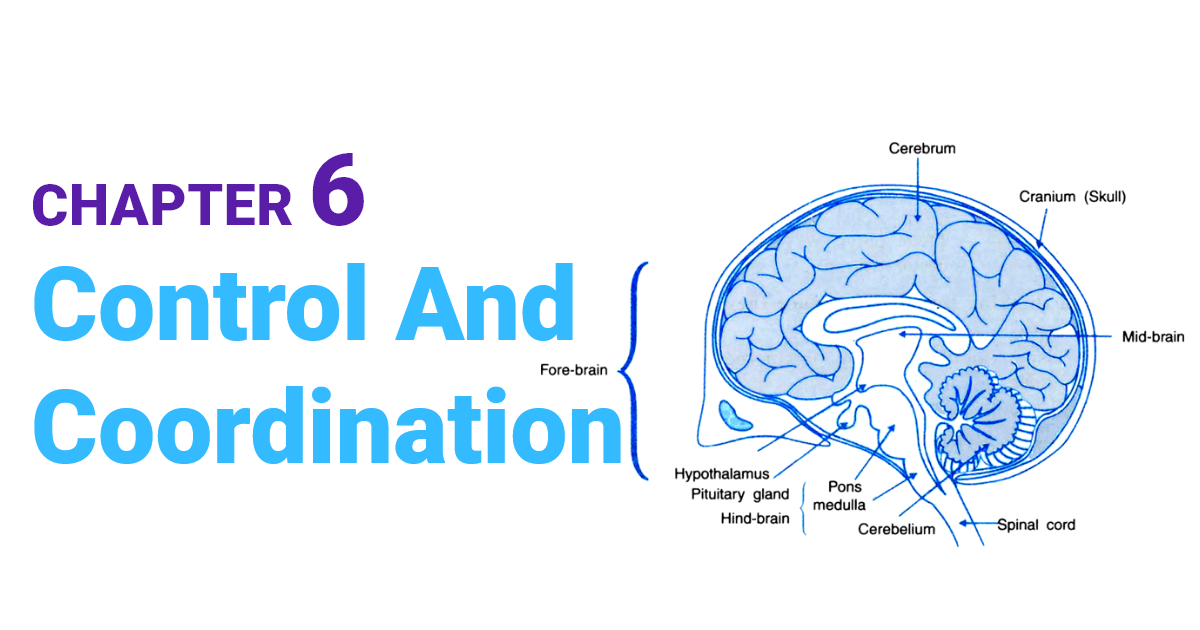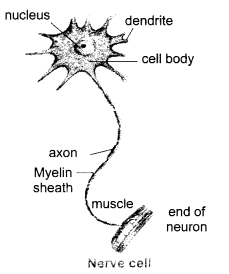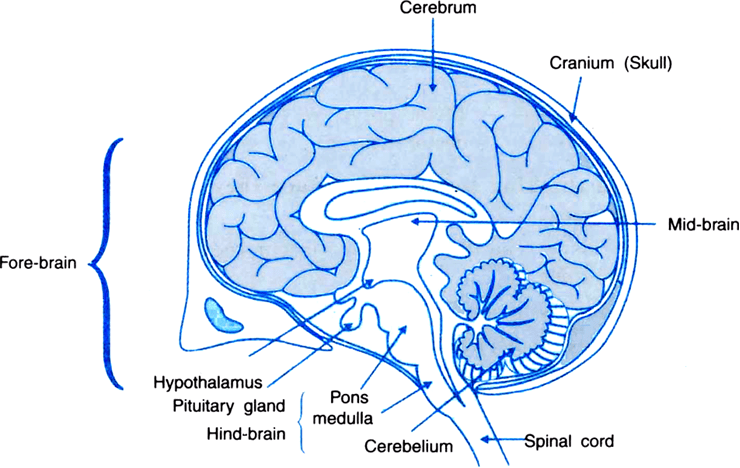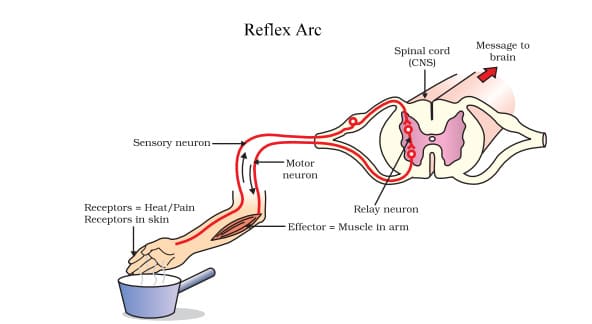In this article, you will learn all about NCERT solutions for class 10 science Chapter 6 control and coordination. You will also find all about class 10 additional questions with answers to class 10 control and coordination.
You will find the answer to every question in Class 10 Science Chapter 6 Notes along with complete stepwise solutions for a better understanding of the questions. This will help you in your home assignments and also in your practice sessions.
Read on to learn all about Control and Coordination Class 10.
Free Download NCERT Solutions For Class 10 ScienceChapter 6 Control & Coordination PDF In Hindi & English Medium For CBSE, Uttarakhand, Bihar & MP Board Students, Gujarat Board & UP Board Students Using NCERT Books Based On CBSE Revised Syllabus 2022-23.

NCERT Solutions for Class 10 Chapter 6 Control and Coordination
Before going into the specifics of NCERT solutions for class 10 Science Chapter 6 Control and Coordination, let us have a brief overview of the topics and sub-topics covered under class 10 Control and Coordination NCERT questions such as:
- Control and coordination
- Animals – nervous system
- Coordination in plants
- Hormones in animals
- Control And Coordination Class 10 Notes PDF Chapter 7 In Details
- Maths Important Questions for Class 10 NCERT (PDF)
- Best Notes Making Format, Ideas And Examples 2023
- Heritage Of India GSEB Class 10 Notes PDF S.S. Ch. 01
NCERT Solutions for Class 10 Control and COordination Textbooks Question Solution
Question 1
Which of the following is a plant hormone?
(a) Insulin
(b) Thyroxin
(c) Oestrogen
(d) Cytokinin
Answer:
(d) Cytokinin
Question 2
The gap between two neurons is called a
(a) dendrite
(b) synapse
(c) axon
(d) impulse
Answer:
(b) Synapse
Question 3
The brain is responsible for
(a) thinking
(b) regulating the heartbeat
(c) balancing the body
(d) all of the above
Answer:
(b) All of the above
Question 4
What is the function of receptors in our body? Think of situations where receptors do not work properly. What problems are likely to arise?
Answer:
A receptor is a specialized cell located in your sense organs such as your ears, nose, skin, your tongue and your eyes. A receptor’s job is to pick up information from your environment. Olfactory receptors, for example, pick up your body’s sense of smell. If your receptors aren’t working correctly, the information you get from your environment will take longer to reach your brain or spinal cord. In this case, the body’s response to an environmental stimulus is delayed, causing harm to your body. For instance, if you have damaged skin receptors, and you happen to touch a hot object on your hands, then your hands will burn because the damaged skin receptor won’t be able to sense external stimuli like heat and pain
Question 5
Draw the structure of a neuron and explain its function.
Answer:
The nerve cell or neuron is the functional unit of the nervous system. A nerve cell has three parts-
(i) cell body
(ii) dendrite
(iii) axon
Function: Nerve cells are responsible for transmitting messages in the form of nerve impulses. Nerve cells receive a signal to send to the spinal cord, which in turn sends a signal to the brain, which then sends a message to the target organ.

Question 6
How does phototropism occur in plants?
Answer:
The shoot of the plant shows positive phototropism and the roots show negative phototropism.
Phototropism in plants occurs due to the hormone auxin. When light falls on one side of a plant, the secretion of auxin hormone is more in the part away from the light. Hence, auxin causes growth in the length of the cells in the shady part. So, the plant appears to bend towards light.
Question 7
Which signals will get disrupted in case of a spinal cord injury?
Answer:
(i) All the involuntary actions will get disturbed.
(ii) Reflex actions will be disturbed because reflexes are located in the spinal cord. Therefore, the quick responses required to safeguard the body will not take place.
Question 8
How does chemical coordination occur in plants?
Answer:
Plants have their own way of communicating through chemical coordination, thanks to a group of compounds known as plant hormones. These special substances are secreted by cells in regions where growth and division are happening, known as meristematic regions. They carry vital information and pass it along by triggering responses in neighboring cells, effectively orchestrating the plant’s development. It’s like a natural language that plants use to talk to each other!
Question 9
What is the need for a system of control and coordination in an organism?
Answer:
An organism needs control and coordination system for the following functions :
(i) To save the body of the organisms from the harmful changes in the environment.
(ii) To control the speed of voluntary and involuntary actions.
(iii) To have the capability to think and learn to respond to any stimuli.
Question 10
How are involuntary actions and reflex actions different from each other?
Answer:
| Involuntary actions | Reflex actions |
| 1. Those actions which occur immediately without any thinking are called involuntary actions. | 1. Reflex action is an immediate response to an event which does not require any processing by brain. |
| 2. Involuntary actions are controlled by mid and hind brain. Example: Breathing, beating of heart, etc. | 2. Reflex actions are controlled by spinal cord. Example: Sneezing, coughing, etc. |
Question 11
Compare and contrast nervous and hormonal mechanisms for control and coordination in animals.
Answer:
| Nervous mechanism | Hormonal mechanism |
| It is a fast process. | It is a slow process. |
| Arteries and glands are affected. | It affects the target organ. |
| It transmits in electrochemical form. | It transmits in chemical form. |
| It does not control metabolism. | It controls metabolism. |
| Growth is not affected. | Growth is affected. |
Question 12
What is the difference between the manner in which movement takes place in a sensitive plant and the movement in our legs?
Answer:
| Movement in a sensitive (mimosa) plant | Movement in legs of a human |
| 1. The leaves of a sensitive plant like mimosa are sensitive to touch. | 1. Leg is in control of nerve muscles. |
| 2. It is not controlled by any part of the plant. | 2. It is controlled by brain and spinal cord. |
| 3. In this, cells change their shape on changing the amount of water in them. | 3. Amount of water has no effect on the movement of muscles. |
| changing the amount of water in them. | the movement of muscles. |
| 4. The movement in a sensitive plant are nastic movement. | 4. The movement in our legs is due to the voluntary nervous system. |
spinal cord and take place immediately without thinking of how to respond to the stimuli.
Control and Coordination Class 10 Important🔥Questions
- Human Brain:
The human brain is a highly complex organ, which is mainly composed of nervous tissue. The tissues are highly folded to accommodate a large surface area in less space. The brain is covered by a three-layered system of membranes, called meninges. Cerebrospinal fluid is filled between the meninges. The CSF providers cushion the brain against mechanical shocks. Furthermore, protection. The human brain can be divided into three regions, viz. forebrain, midbrain and hindbrain.
Parts of the Human Brain:
- Fore-brain: It is composed of the cerebrum.
- Mid-brain: It is composed of the hypothalamus.
- Hind-brain: It is composed of the cerebellum, pons, medulla, and oblongata.

Some main structures of the human brain are explained below :
Cerebrum: The cerebrum is the largest part of the human brain. It is divided into two hemispheres called cerebral hemispheres.
Functions of cerebrum
- The cerebrum controls voluntary motor actions.
- It is the site of sensory perceptions, like tactile and auditory perceptions.
- It is the seat of learning and memory.
Hypothalamus: The hypothalamus lies at the base of the cerebrum. It controls the sleep and wake cycle (circadian rhythm) of the body. It also controls the urges for eating and drinking.
Cerebellum: Cerebellum lies below the cerebrum and at the back of the whole structure. It coordinates the motor functions. When you are riding your bicycle, the perfect coordination between your pedalling and steering control is achieved by the cerebellum.
- It controls posture and balance.
- It controls the precision of voluntary action.
Medulla: Medulla forms the brain stem, along with the pons. It lies at the base of the brain and continues into the spinal cord. The medulla controls various involuntary functions, like heartbeat respiration, etc.
It controls involuntary actions.
Example: Blood pressure, salivation, vomiting.
Pons: It relays impulses between the lower cerebellum and spinal cord, and higher parts of the brain like the cerebrum and midbrain, also regulate respiration.
Spinal cord: The spinal cord controls the reflex actions and conducts messages between different parts of the body and brain.
- What happens in Reflex Actions?
Reflex Action: Reflex action is a special case of involuntary movement of involuntary organs. When a voluntary organ is in the vicinity of sudden danger, it is immediately pulled away from the danger to save itself. For example, when your hand touches a very hot electric iron, you move away your hand in a jerk. All of this happens in a flash and your hand is saved from the imminent injury. This is an example of reflex action.

Reflex Arc: The path through which nerve signals, involved in a reflex action, travel is called the reflex arc. The following flow chart shows the flow of signal in a reflex arc.
Receptor → Sensory neuron → Relay neuron → Motor neuron → Effector (muscle)
The receptor is the organ which comes in the danger zone. The sensory neurons pick signals from the receptor and send them to the relay neuron. The relay neuron is present in the spinal cord. The spinal cord sends signals to the effector via the motor neuron. The effector comes in action and moves the receptor away from the danger.
Difference between Contrast Nervous and Hormonal Mechanisms in animals
| Nervous Mechanisms | Hormonal Mechanisms |
|---|---|
| Nervous mechanisms involve the transmission of electrical signals through specialized cells called neurons. These signals allow for rapid communication and coordination within an animal’s body. | Hormonal mechanisms involve the secretion and circulation of chemical messengers called hormones. These hormones are produced by specialized cells or glands and are released into the bloodstream to reach target tissues or organs. |
| Nervous mechanisms are responsible for quick, short-term responses to stimuli, often involving immediate adjustments to behavior or body functions. | Hormonal mechanisms are relatively slower compared to nervous mechanisms, as hormones travel through the bloodstream to reach their target sites. |
| Hormonal mechanisms are involved in the long-term regulation, growth, development, reproduction, and maintenance of various physiological processes in the body. | Nervous mechanisms are highly specific and precise, targeting specific cells, tissues, or organs. They can transmit signals over short distances (local signalling) or long distances (long-range signalling). |
| Examples of nervous mechanisms include reflex actions (such as pulling your hand away from a hot object) and the transmission of sensory information to the brain for processing. | Nervous mechanisms are responsible for quick, short-term responses to stimuli, often involving immediate adjustments to behaviour or body functions. |
